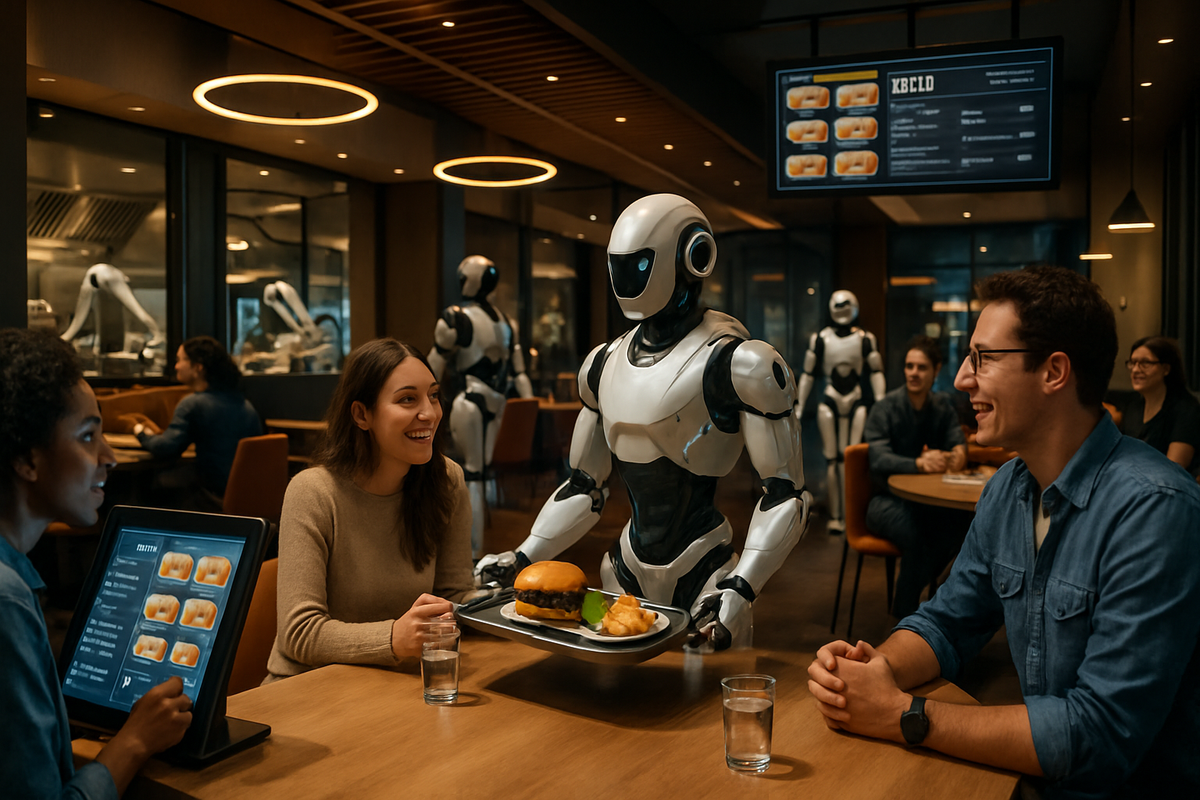The Ultimate Guide to Building Your Own Automated Restaurant: Tech, Costs, and Step-by-Step Playbook (2025 Edition)
Step into 2025 as you launch your automated restaurant, combining culinary dreams with sci-fi tech for unmatched profits and efficiency. No robotics degree required—transform dining with our step-by-step guide to future-proof your business today.

Welcome to your definitive roadmap to launching a next-generation, automated restaurant in 2025—a journey where culinary dreams and cutting-edge tech unite to serve up profits, efficiency, and a splash of sci-fi flair. Whether you’re a seasoned operator, a serial entrepreneur, or just someone tired of hearing, “Sorry, we’re short-staffed tonight,” this guide is your passport to the future of dining.
Why Build an Automated Restaurant in 2025?
“The smart restaurant robot industry is expected to exceed $10 billion by 2030.”
— Archive Market Research, July 2025
- Labor shortages? Robots don’t call out sick or forget your table’s order.
- Rising costs? Automation slashes operational expenses by up to 40% in some cases.
- Demand for speed and consistency? AI and robotics deliver both, 24/7.
But here’s the kicker: you don’t need a PhD in robotics or a billionaire’s bank account to get started. Let’s break it down, step by step.
Step 1: Define Your Automation Vision
Automated restaurants run the gamut, from burger joints with robot cooks to sushi bars with conveyor belts and AI-powered order kiosks. Start by asking:
- Full Automation: No humans in the loop (think: Flippy the fry-cook, robot waiters, self-cleaning kitchens).
- Partial Automation: Humans and robots working in harmony (robotic food runners, AI order-takers, but with a human manager for the personal touch).
Pro tip: Many successful 2025 launches combine both, automating the repetitive tasks and freeing humans to focus on hospitality and creative cuisine.
Step 2: Tech Shopping List—Robots, AI, and Beyond
What You’ll Need:
- Kitchen Robotics: Fryers, grillbots, salad or pizza assembly lines (see: Miso Robotics, Bear Robotics, XRobotics).
- Front-of-House Automation: Robot servers, conveyor belts, self-order kiosks, and AI-powered POS (Toast, Square for Restaurants, Shopify integrations).
- AI Software: Menu optimization, demand forecasting, automated marketing (think: SaaS platforms for scheduling, inventory, and customer engagement).
- Payment & Security: Contactless, cloud-based POS, facial recognition or QR code entry, secure payment gateways.
Estimated Costs (2025):
- Kitchen Robot (per station): $30,000–$90,000
- Robot Server: $15,000–$35,000 each
- Self-Order Kiosk: $3,000–$8,000 per unit
- AI SaaS (monthly): $200–$2,000 (scale based)
- Installation & Integration: $15,000–$50,000 (depends on legacy systems and build-out complexity)
“Hotels implementing automation are seeing operational costs drop by 30%–40%, along with enhanced guest satisfaction.”
— RICentral.com, August 2025
Step 3: Mapping Your Build—The Playbook
- Market Research: What’s trending in your city? (Sushi bots? Pizza robots? Cocktail droids?)
- Business Plan & Financing: Work out your total investment. Consider small business loans, grants, or tech-focused investors. (Check Bluevine, Restaurant Depot, and other partners.)
- Site Selection: Look for spaces with good power supply, fiber internet, and open layouts. Automation needs room to roam!
- Vendor Selection: Compare robotics providers, POS options, and SaaS platforms. Negotiate support, maintenance, and training contracts.
- Permits & Legal: Automated kitchens still need food safety and health permits. Consult local codes—AI may be new, but food law is eternal.
- Design & Integration: Work with architects and system integrators to make tech and ambiance play nice together. Don’t forget charging stations and maintenance access.
- Staffing: Yes, you’ll still need humans! Tech supervisors, customer liaisons, and maintenance pros keep things humming.
- Test, Iterate, Launch: Run soft openings. Gather feedback. Tweak workflows and software. Then, open the (automatic) doors!
“Robots are cooking, serving, and delivering in restaurants, helping with labor shortages and rising food costs.”
— PYMNTS.com, July 2025
Step 4: The Human Element—Don’t Automate Away the Soul
Let’s face it: the best tech enhances, not replaces, hospitality. Even the most robotic eatery needs:
- Brand Personality: Quirky robots, witty digital signage, or playful menu copy. Delight your guests with surprise and charm.
- Feedback Loops: Use AI to analyze reviews and social chatter. Adapt fast—your customers are your ultimate beta testers.
- Community: Host events, offer behind-the-scenes robot tours, or let regulars name your house droid. Make the experience memorable and shareable.
Step 5: Measuring ROI—The Numbers Don’t Lie
Here’s a sample ROI breakdown for a mid-sized, partially automated restaurant:
- Upfront Investment: $250,000–$600,000 (tech, build-out, training)
- Annual Operating Savings: 25%–40% reduction compared to traditional models (labor, shrinkage, utilities)
- Payback Period: 2–4 years (faster in high-labor markets or with strong foot traffic)
- Bonus: Enhanced marketing buzz, higher check averages, and a loyal, tech-loving customer base
Note: For a custom calculator, spreadsheet templates, and vendor lists, join our community of Funaix Insiders. Subscribe for free at funaix.com—not only will you get exclusive tips, but you’ll be able to discuss, comment, and connect with other automation pioneers. (Subscribers can comment—insiders only!)
Pitfalls & Pro Tips: Wisdom from the Front Lines
- Don’t over-automate. Not every task needs a robot. Focus on bottlenecks and high-labor pain points first.
- Maintenance is real. Robots need love, too. Budget for ongoing service contracts and have a tech on speed dial.
- Train your team. Upskill your staff to manage and troubleshoot. A happy, tech-savvy crew is your secret weapon.
- Stay flexible. The AI/robotics landscape evolves fast. Choose modular systems that can adapt to tomorrow’s trends.
“Within a few years, customers may not blink an eye at being served a meal entirely by robots—or at least automated kitchens overseen by human staff.”
— HospitalityTech.com, January 2025
Resource Directory: Your Automation Launchpad
- Robotics Vendors: Miso Robotics, Bear Robotics, XRobotics
- POS & Payments: Toast POS, Square for Restaurants, Shopify
- AI SaaS & Analytics: Check for industry-specific platforms with open APIs
- Commercial Real Estate: Seek brokers who understand automation needs
- Insurance: Hospitality tech policies from NEXT Insurance and others
- Financing: Bluevine, traditional SBA loans, or tech-focused VCs
Want a deeper dive? Subscribe as a Funaix Insider to unlock detailed vendor reviews, cost breakdowns, and community Q&A. It’s free (for now!), and only subscribers can comment or join the conversation.
Ready to serve up the future? Don’t just watch the robot revolution—lead it! Subscribe now to join our smart, spirited community of automation pioneers.
(P.S. Only insiders get to comment, ask questions, and swap stories. Pull up a (robotic) chair!)




